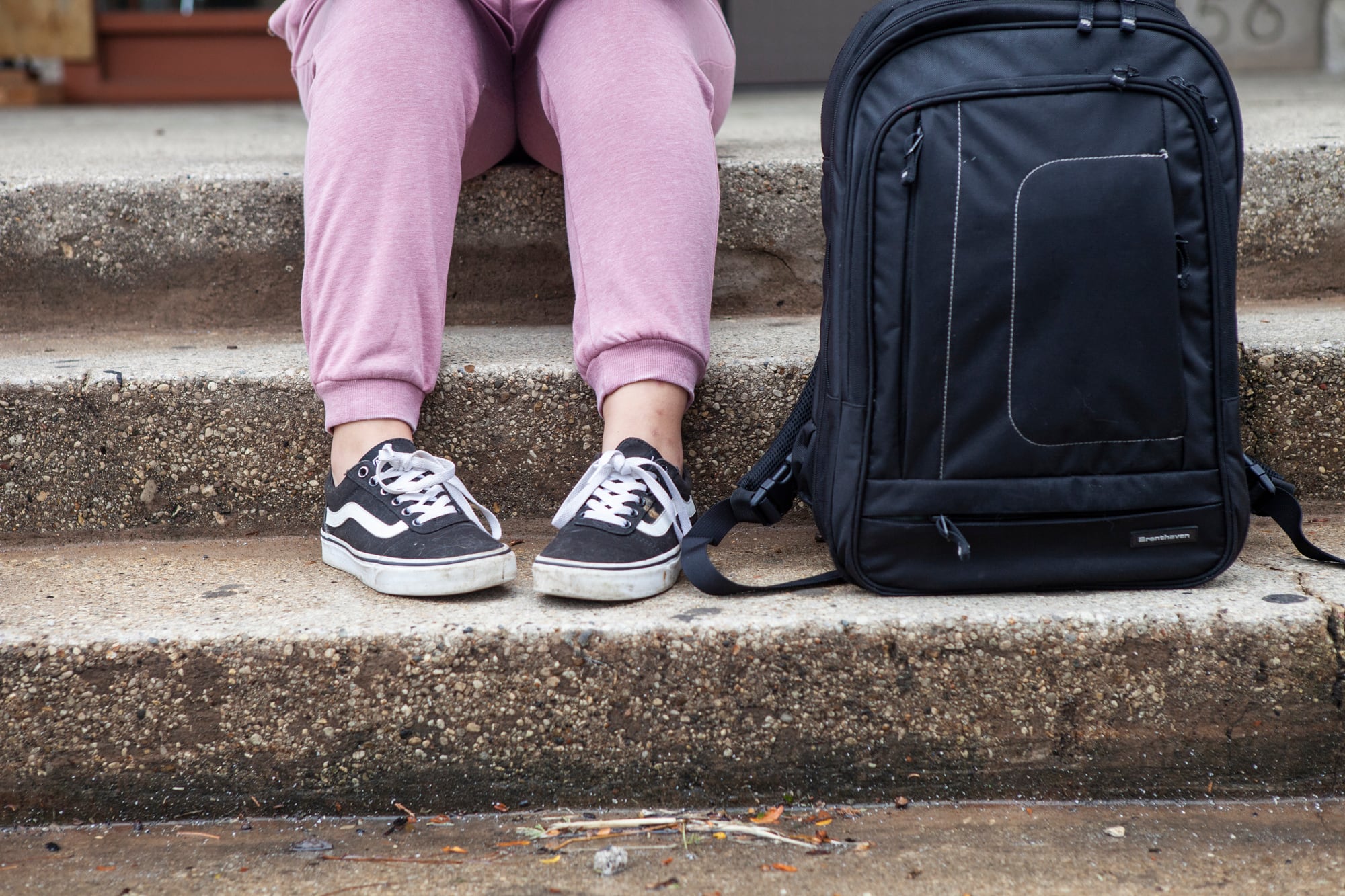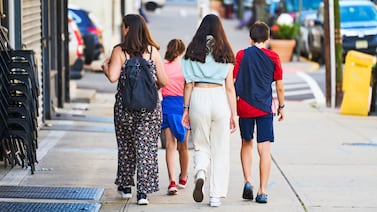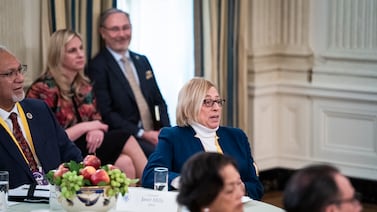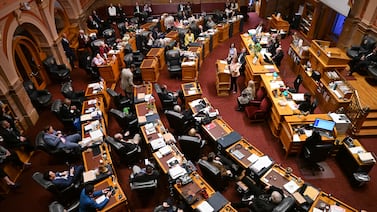Sign up for Chalkbeat Chicago’s free daily newsletter to keep up with the latest education news.
Chicago Public Schools unveiled a new five-year strategic plan Monday that sets out to increase the number of students attending schools in their neighborhood and redefine what it means to be a successful student.
The plan did not call for specific changes to selective enrollment, magnet, or charter schools, a possibility signaled in December when the board first announced its intention to rethink school choice. But the plan does seek to bolster resources for neighborhood schools “with an intentional focus on disinvested communities.”
Roughly 44% of elementary school students enrolled at a school other than the one they were zoned for in the 2022-23 school year, while about 75% of high schoolers did the same, according to district data.
Twenty years ago, when Chicago started expanding magnet, selective, and charter schools, just about a quarter of elementary school students enrolled in schools outside of their attendance area and 46% of high schoolers did the same.
The plan outlines priorities and specific goals to reach by 2029 in three different areas — students, schools, and communities — but did not signal policy changes. Officials, however, left the possibility open for future changes as a result of the plan.
“I don’t think this document is intended to indicate new policies,” Chicago Board of Education Vice President Elizabeth Todd-Breland told reporters. “As engagement continues around the different topics and areas there, if a policy change is seen as necessary, then perhaps that will be the case.”
The board will vote on the plan on Wednesday at a special meeting.
Under the plan, the district set the following goals to reach by 2029:
- Increase the percentage of students who attend a school in their neighborhood or community area. The district said it does not have a specific percentage it wants to reach, and that this is not just limited to a student’s zoned school.
- Increase the number of students in grades 3-8 who pass the state’s reading and math exams by 20%.
- Reduce chronic absenteeism – when a student misses 10 or more days of school – by 15%.
- Reduce teacher vacancies by 25% in schools that serve majorities of Black and Hispanic students.
- Increase funding for improving school facilities by $250 million.
- Increase internet bandwidth by 400% at elementary schools and by 900% at high schools to prevent outages and slow internet connections.
- Ensure that all schools will have a “robust” behavioral health team.
- Decrease class sizes, with priority on schools with higher needs.
- Ensure that all schools have the capacity to hire arts, P.E., and other “special instruction” staff.
- Increase the percentage of students enrolled in at least one district after-school program by 8 percentage points, from 42% currently to 50%.
- Transition 25% of personnel who come from the private sector, such as custodians and bus drivers, to district employees.
District wants to redefine student success
The plan also outlines specific priorities for certain groups of students. For example, the district said it wants to improve achievement and opportunities for Black students, who are disproportionately less likely to read and do math on grade level compared to their peers and are disciplined at higher rates; ensure students learn more than one language by the time they graduate and boost support for English learners; and improve quality of education and instruction for both students with disabilities and kids in pre-K through second grade.
District officials and school board leaders also want more emphasis on how students experience school.
Officials said the district will continue to track things like graduation rate and student growth and proficiency on subjects for their grade level. But it will also consider other factors when considering student and school success, such as how well schools are supporting students who are chronically absent, how many students are participating in early college and career credit programs, and if schools are providing “high quality curriculum,” according to CPS CEO Pedro Martinez and Chief Education Officer Bogdana Chkoumbova.
The district has also set an explicit goal to improve the number of schools rated strongly as “supportive environments” on the annual 5Essentials survey, which comes from the University of Chicago Consortium on School Research and is supposed to measure a school’s culture and climate.
“Social-emotional learning, student well-being, it’s not an add-on,” Todd-Breland said. “If it’s not deeply integrated into everything that we do, then learning cannot happen.”
The district also included priorities to increase funding for all of its schools.
Todd-Breland said board meetings will soon be restructured so they monitor the plan’s goals, “so that every month when you come to a board meeting, you’re going to find out something new about how the strategic plan is being monitored and how things are moving.”
But it’s unclear if that meeting structure will remain come January when the school board grows from 7 appointed members to 21 members, 10 of whom will be elected by Chicago voters on Nov. 5.
Strategic plan comes amid change, tensions at CPS
Martinez and his administration unveiled the plan eight months after the school board passed a resolution signaling the district’s intent to curtail a choice system that leaders said has undermined many neighborhood schools and bred inequities in the experience of students in different parts of the city.
That resolution was in keeping with campaign promises by Mayor Brandon Johnson, a former Chicago Teachers Union organizer, who called the district’s system “a Hunger Games scenario” in which families scramble to flee their neighborhood campuses for spots in coveted test-in and lottery programs across the city. Chicago’s selective enrollment, magnet, and charter schools are also prized by many families, and district leaders have spent the intervening months reassuring state lawmakers, parents, and others that they won’t close or severely weaken these choices.
Asked why the plan revealed Monday did not include explicit policy changes for choice schools, Todd-Breland said the board heard from people who valued schools beyond their neighborhood options, including selective enrollment and charter schools.
“What felt more important, and what continues to be the more important thing … is that the lever of change in Chicago Public Schools is to invest in neighborhood schools and our communities furthest from opportunity to make sure there are pathways that families are confident in and have high quality education provided in them from pre-K through high school in their neighborhood,” Todd-Breland said.
Still, the strategic plan says academic gaps among students and challenges have worsened because of “our current competitive enrollment policies and previous accountability policy, which pitted schools against each other and sorted students based on academic performance in an under-resourced system, reinforcing cycles of inequity.”
Martinez is putting out the plan just as reports emerged that Johnson might be gearing up to replace him following disagreements with City Hall over how to tackle budget deficits and rocky contract negotiations with the Chicago Teachers Union. Those reports raise questions about the district’s ability to see the new blueprint through, after a run of frequent CEO comings-and-goings that have destabilized CPS.
In a statement, CTU president Stacy Davis Gates said the “best parts” of the plan mirror the union’s current contract proposals with the district and that, at the bargaining table, Martinez is “out of step” with his own district.
“If the district actually led with this plan, then we’d have the partner we’re looking for to deliver for our students,” Davis Gates said.
Efforts to reinvigorate Chicago’s neighborhood schools date back to the tenure of Martinez’s predecessor, Janice Jackson, who served for three and a half years. She launched “equity grants” to give campuses with shrinking enrollment a funding boost as well as a program in which schools applied for dollars to start specialized programming, such as arts or STEM, in a bid to lure families seeking distinctive learning options. Jackson’s own five-year plan also emphasized improving how the district serves its Black students, especially Black boys.
After the school board’s December resolution, Martinez’ administration disclosed few details about the development of a new strategic plan, with officials saying they wanted to first hear from community members at a series of public meetings this spring. Officials said Monday that nearly 14,000 people “engaged” with the plan by providing feedback or attending community meetings.
But for some, the wait for more details on the plan produced anxiety about the future of school choice in Chicago. Families in the district’s selective enrollment and magnet programs worried those schools would be diminished – a claim CPS officials repeatedly denied and is not a part of the strategic plan released Monday. On some campuses, those worries spiked as the district unveiled a new approach to school budgeting in the spring that district leaders said would steer more dollars to campuses with the highest needs and correct for historical inequities in how Chicago distributed resources. At some selective schools, officials and parents said newly tight budgets made it hard to staff specialized programs.
The plan released Monday calls for the district to monitor both the strengths and weaknesses of the new funding formula.
In the spring, state lawmakers introduced a bill threatening to intervene if Chicago moved to close any of its selective and magnet programs. The bill didn’t gain traction during the legislative session, but it elicited reassurance from Johnson and district leaders that there were no plans to shutter these schools.
Anxiety has also run high among charter operators and families, who felt that the December resolution was taking clear aim at their schools. Last week, charter officials and parents rallied at a school board meeting to demand more clarity on the plan and a promise that it won’t undermine the city’s charters, which serve roughly a fifth of its students.
The plan calls for revisiting the district’s renewal process for charter schools in a couple of years, but provides no additional details.
Reema Amin is a reporter covering Chicago Public Schools. Contact Reema at ramin@chalkbeat.org .
Mila Koumpilova is Chalkbeat Chicago’s senior reporter covering Chicago Public Schools. Contact Mila at mkoumpilova@chalkbeat.org







